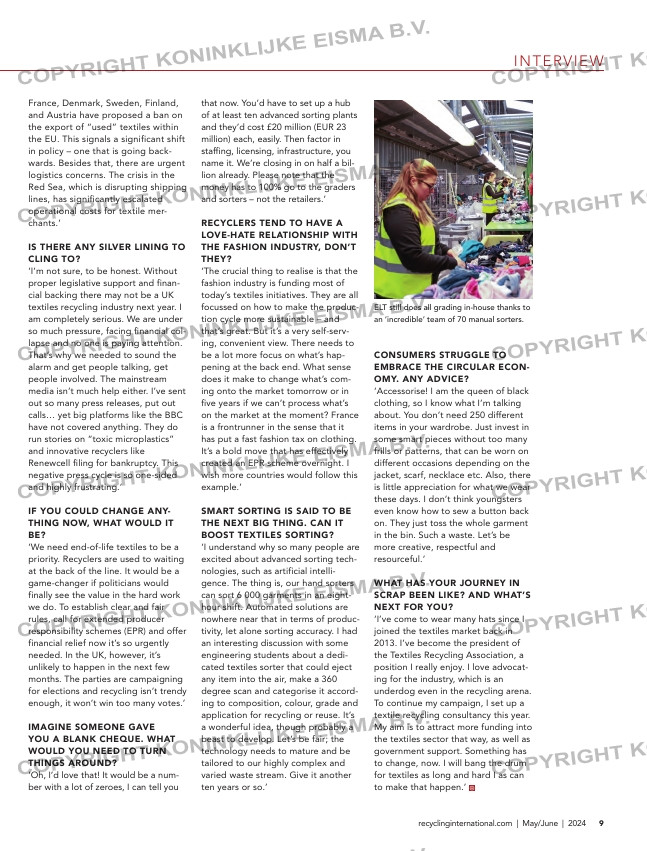Page 9 from: What’s inside?

9recyclinginternational.com | May/June | 2024
INTERVIEW
It’s a critical time for textiles recyclers who need ‘all hands on deck’ across the value chain, insists Dawn Dungate,
director of sustainability for East London Textiles (ELT). This is especially true in the UK, where operators say they are
facing financial collapse. The textiles expert, who is also president of the national UK Textiles Recycling Association,
is calling for urgent action to save her industry.
France, Denmark, Sweden, Finland,
and Austria have proposed a ban on
the export of “used” textiles within
the EU. This signals a significant shift
in policy – one that is going back-
wards. Besides that, there are urgent
logistics concerns. The crisis in the
Red Sea, which is disrupting shipping
lines, has significantly escalated
operational costs for textile mer-
chants.’
IS THERE ANY SILVER LINING TO
CLING TO?
‘I’m not sure, to be honest. Without
proper legislative support and finan-
cial backing there may not be a UK
textiles recycling industry next year. I
am completely serious. We are under
so much pressure, facing financial col-
lapse and no one is paying attention.
That’s why we needed to sound the
alarm and get people talking, get
people involved. The mainstream
media isn’t much help either. I’ve sent
out so many press releases, put out
calls… yet big platforms like the BBC
have not covered anything. They do
run stories on “toxic microplastics”
and innovative recyclers like
Renewcell filing for bankruptcy. This
negative press cycle is so one-sided
and highly frustrating.’
IF YOU COULD CHANGE ANY-
THING NOW, WHAT WOULD IT
BE?
‘We need end-of-life textiles to be a
priority. Recyclers are used to waiting
at the back of the line. It would be a
game-changer if politicians would
finally see the value in the hard work
we do. To establish clear and fair
rules, call for extended producer
responsibility schemes (EPR) and offer
financial relief now it’s so urgently
needed. In the UK, however, it’s
unlikely to happen in the next few
months. The parties are campaigning
for elections and recycling isn’t trendy
enough, it won’t win too many votes.’
IMAGINE SOMEONE GAVE
YOU A BLANK CHEQUE. WHAT
WOULD YOU NEED TO TURN
THINGS AROUND?
‘Oh, I’d love that! It would be a num-
ber with a lot of zeroes, I can tell you
that now. You’d have to set up a hub
of at least ten advanced sorting plants
and they’d cost £20 million (EUR 23
million) each, easily. Then factor in
staffing, licensing, infrastructure, you
name it. We’re closing in on half a bil-
lion already. Please note that the
money has to 100% go to the graders
and sorters – not the retailers.’
RECYCLERS TEND TO HAVE A
LOVE-HATE RELATIONSHIP WITH
THE FASHION INDUSTRY, DON’T
THEY?
‘The crucial thing to realise is that the
fashion industry is funding most of
today’s textiles initiatives. They are all
focussed on how to make the produc-
tion cycle more sustainable – and
that’s great. But it’s a very self-serv-
ing, convenient view. There needs to
be a lot more focus on what’s hap-
pening at the back end. What sense
does it make to change what’s com-
ing onto the market tomorrow or in
five years if we can’t process what’s
on the market at the moment? France
is a frontrunner in the sense that it
has put a fast fashion tax on clothing.
It’s a bold move that has effectively
created an EPR scheme overnight. I
wish more countries would follow this
example.’
SMART SORTING IS SAID TO BE
THE NEXT BIG THING. CAN IT
BOOST TEXTILES SORTING?
‘I understand why so many people are
excited about advanced sorting tech-
nologies, such as artificial intelli-
gence. The thing is, our hand sorters
can sort 6 000 garments in an eight-
hour shift. Automated solutions are
nowhere near that in terms of produc-
tivity, let alone sorting accuracy. I had
an interesting discussion with some
engineering students about a dedi-
cated textiles sorter that could eject
any item into the air, make a 360
degree scan and categorise it accord-
ing to composition, colour, grade and
application for recycling or reuse. It’s
a wonderful idea, though probably a
beast to develop. Let’s be fair; the
technology needs to mature and be
tailored to our highly complex and
varied waste stream. Give it another
ten years or so.’
CONSUMERS STRUGGLE TO
EMBRACE THE CIRCULAR ECON-
OMY. ANY ADVICE?
‘Accessorise! I am the queen of black
clothing, so I know what I’m talking
about. You don’t need 250 different
items in your wardrobe. Just invest in
some smart pieces without too many
frills or patterns, that can be worn on
different occasions depending on the
jacket, scarf, necklace etc. Also, there
is little appreciation for what we wear
these days. I don’t think youngsters
even know how to sew a button back
on. They just toss the whole garment
in the bin. Such a waste. Let’s be
more creative, respectful and
resourceful.’
WHAT HAS YOUR JOURNEY IN
SCRAP BEEN LIKE? AND WHAT’S
NEXT FOR YOU?
‘I’ve come to wear many hats since I
joined the textiles market back in
2013. I’ve become the president of
the Textiles Recycling Association, a
position I really enjoy. I love advocat-
ing for the industry, which is an
underdog even in the recycling arena.
To continue my campaign, I set up a
textile recycling consultancy this year.
My aim is to attract more funding into
the textiles sector that way, as well as
government support. Something has
to change, now. I will bang the drum
for textiles as long and hard I as can
to make that happen.’
ELT still does all grading in-house thanks to
an ‘incredible’ team of 70 manual sorters.
KADERKOP
??
08-09_interview.indd 9 24-04-2024 14:03



